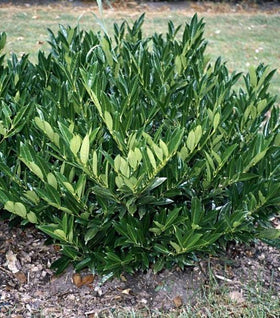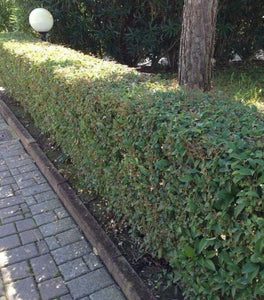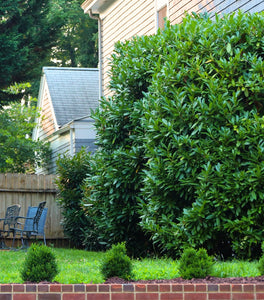Images Depict Mature Plants
Zabeliana Cherry Laurel Shrubs for Sale Online
Zabeliana Cherry Laurel is a more compact version of the skip cherry laurel. Growing more horizontal when young, this evergreen shrub becomes more mounded as it ages. The dark green foliage remains even in the toughest winters in zone 6. The clusters of fragrant pure white flowers of this dwarf Cherry Laurel bloom in spring and are followed by small black berries in summer.
In warmer areas of the country, Zabeliana Cherry Laurel does best in part sun, and further into its northern range; it can tolerate full sun. Zabeliana Cherry Laurel prefers rich, evenly moist, well-drained soils. It will not tolerate soils that remain wet for extended periods.
The Zabel's dwarf Cherry Laurel is a good choice for those searching for a mid-sized privacy hedge. It does not grow as tall as the skip laurel and tends to get wider. It can easily be kept to shorter heights and skinnier widths with a once-per-year pruning.
| Hardiness Zone: | 6-9 |
|---|---|
| Mature Height: | 3 to 5 Feet |
| Mature Width: | 5 to 6 Feet |
| Classification: | Broad leaved evergreen shrub |
| Sunlight: | Full sun to part shade |
| Habit: | Densely branched, upright |
| Foliage: | Dark green |
| Flower Color: | White fragrant flowers that produce red berries |
| Pruning Season: | Prune in spring after flowering if needed |
| Soil Condition: | Any well drained soil |
| Water Requirements: | Water well until established |
| Uses: | Extremely attractive when used as in the mixed border, foundations, or as a privacy hedge |

How to Care for Zabeliana Cherry Laurel
Be sure to read our planting instructions to ensure a healthy and happy plant for years to come!
How Do I Fertilize Schip Cherry Laurels?
Plants such as Schip Cherry Laurel grow best if they are fertilized once in the spring and again in early summer. Laurels benefit from nutrient-rich fertilizers that raise the acid level of the soil, such as Holly-Tone by Espoma. Organic additions to the soil can also be combined with a shot of chemical fertilizer for maximum effect. If you choose to use chemical fertilizers, applying a slow-release, balanced fertilizer once a year in the spring. Over-fertilization can be much more detrimental than under-fertilization, so be sure to follow the directions closely. Don't fertilize Schip Cherry Laurel after August. Fertilizing at this time may stimulate new growth that will be too tender to withstand the winter.













